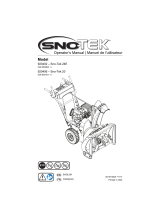
GB - 7
ALWAYS keep hands and feet away from all rotating
parts during operation. Rotating parts can cut off body
parts.
NEVER place your hands or any part of your body or
clothing inside or near any moving part while unit is
running.
ALWAYS keep hands away from all pinch points.
DO NOT touch unit parts which might be hot from
operation. Allow parts to cool before attempting to
maintain, adjust or service.
Never direct discharge towards persons or property
that may be injured or damaged by thrown objects. Use
extreme caution on gravel surfaces. Stay alert for
hidden hazards or traffic. Adjust Runners so Scraper
Blade does not contact gravel.
DO NOT throw snow any higher than necessary.
Deflected materials can cause injury and property
damage.
Always stand clear of the discharge area when
operating this unit.
Fumes from engine exhaust can cause injury or death.
DO NOT run engine in an enclosed area. Always
provide good ventilation.
ALWAYS disengage attachment, stop unit and engine,
remove key and allow moving parts to stop before
leaving operator’s position.
ROTATING IMPELLER CAN CAUSE SERIOUS
INJURY. NEVER ATTEMPT TO UNCLOG OR CLEAN
UNIT WHILE ENGINE IS RUNNING.
Read, understand, and follow all instructions in the
manual and on the machine before starting.
Understand:
• How to operate all controls.
• The functions of all controls.
• How to STOP in an emergency.
Before starting engine, disengage control(s).
Use only approved extension cords and receptacles
when starting units equipped with electric starter. DO
NOT connect electric starter cord to any wiring system
that is not a three-wire grounded system.
ALWAYS allow unit and engine to adjust to outdoor
temperatures before clearing snow.
Always be sure of your footing, especially when
operating in reverse or leaving the operator’s position.
Walk, never run during operation.
DO NOT overload the machine capacity by attempting
to clear snow at too fast a rate.
DO NOT operate at too fast a rate.
Slow down and turn corners slowly.
Do not operate in reverse unless absolutely necessary.
ALWAYS back up slowly. Always look down and behind
before and while backing.
Disengage attachment drive when traveling from one
work area to another.
Abnormal Vibrations are a warning of trouble. Striking a
foreign object can damage unit. Immediately stop unit
and engine. Remove key and wait for all moving parts
to stop. Remove wire from spark plug. Inspect unit and
make any necessary repairs before restart.
Before cleaning, removing clogs or making any
inspections, repairs, etc.: disengage clutch(es), stop
unit and engine, remove key, allow moving parts to
stop. Allow hot parts to cool.
Run unit a few minutes after clearing snow to prevent
freeze-up of attachment.
Disengage attachment when not in use. Disengage all
clutches before starting engine. Adjust runners to clear
gravel or crushed rock surfaces safely.
Never leave a running unit unattended. ALWAYS shut
off engine before leaving unit. ALWAYS remove key to
prevent unauthorized use.
Never carry passengers.
Check clutch and brake operation frequently. Adjust
and service as required. All motion of drive wheels and
auger/impeller must stop quickly when control levers
are released.
DO NOT operate on steep slopes. DO NOT clear snow
across the face of slopes. Keep all movement on
slopes slow and gradual. DO NOT make sudden
changes in speed or direction. Use a slow speed to
avoid stops or shifts on slopes. Avoid starting or
stopping on a slope.
DO NOT park unit on a slope unless absolutely
necessary. When parking on a slope always block the
wheels.
ALWAYS shut off engine, remove key, and close fuel
shut-off valve or drain fuel when transporting unit on a
truck or trailer.
Use extra care when loading or unloading unit onto
trailer or truck.
Secure unit chassis to transport vehicle. NEVER
secure from rods or linkages that could be damaged.
DO NOT transport machine while engine is running.
Keep unit free of ice or other debris. Clean up oil or fuel
spills.
This product is equipped with an internal combustion
type engine. DO NOT use unit on or near any
unimproved, forest-covered or brush covered land
unless exhaust system is equipped with a spark
arrester meeting applicable local, state or federal laws.
A spark arrester, if it is used, must be maintained in
effective working order by operator.
Fuel is highly flammable and its vapors are explosive.
Handle with care. Use an approved fuel container.
NO smoking, NO sparks, NO flames. ALWAYS allow
engine to cool before servicing.
























